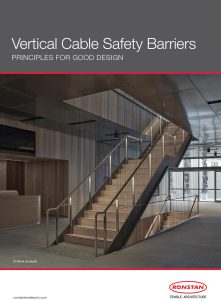
A vertical floor-to-ceiling cable safety barrier offers transparency, visual connection and protection from falls, which has made it a popular solution for enclosing atriums, voids, balconies, stairs, and other elevated spaces. However, the design of tensioned stainless-steel cable barriers is a specialist field, and it requires experience and technical knowledge to understand how the cables themselves should be designed to mate effectively with and transfer the cable loads to the building structure.
Vertical Cable Safety Barriers: Principles for Good Design will help ensure you arrive at an appropriate design that takes into full consideration factors like cable behaviour and the importance of connections. Noting the limitations in the way the National Construction Code and other regulations deal with vertical cable barriers, we look at Eurocode 3 Part 1-11: Design of Structures with Tension Components and ASCE19-16 Structural Applications of Steel Cables for Buildings, which require designers to consider and design for the loads imposed at the cable ends.
Ronstan has been setting the standard for tensile cable structures since 1988. As a world-leading cable manufacturer, designer and builder of cable structures, Ronstan understands how cables stretch and can define the loads and forces in the cable system, keeping the barrier solution buildable and compliant through common sense and practical design suggestions.
Download this whitepaper to learn more about the design considerations of vertical cable safety barriers.
If you would like us to make a presentation at your office or if we can help you develop your concept further, please contact us to discuss your project.